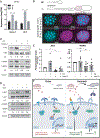Insulin signaling in the long-lived reproductive caste of ants
- PMID: 36048960
- PMCID: PMC9526546
- DOI: 10.1126/science.abm8767
Insulin signaling in the long-lived reproductive caste of ants
Abstract
In most organisms, reproduction is correlated with shorter life span. However, the reproductive queen in eusocial insects exhibits a much longer life span than that of workers. In Harpegnathos ants, when the queen dies, workers can undergo an adult caste switch to reproductive pseudo-queens (gamergates), exhibiting a five-times prolonged life span. To explore the relation between reproduction and longevity, we compared gene expression during caste switching. Insulin expression is increased in the gamergate brain that correlates with increased lipid synthesis and production of vitellogenin in the fat body, both transported to the egg. This results from activation of the mitogen-activated protein kinase (MAPK) branch of the insulin signaling pathway. By contrast, the production in the gamergate developing ovary of anti-insulin Imp-L2 leads to decreased signaling of the AKT/forkhead box O (FOXO) branch in the fat body, which is consistent with their extended longevity.
Figures




References
MeSH terms
Substances
Grants and funding
LinkOut - more resources
Full Text Sources
Other Literature Sources
Medical
Molecular Biology Databases

